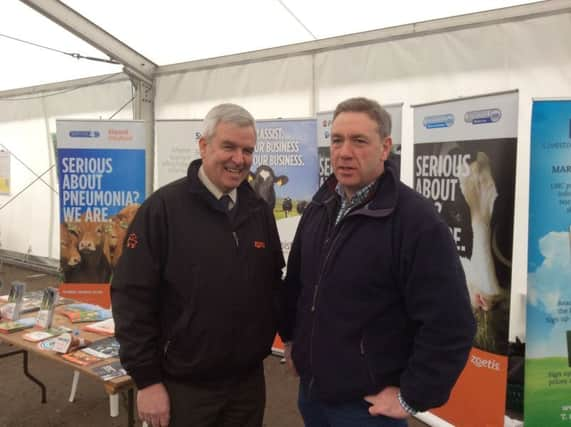Health topics on the agenda at NBA event


Aurelie Moralis, Veterinary Consultant with Zoetis, discussed these topics with a number of farmers on their stand.
She commented: “Farmers realise that these aspects have a major impact on the profitability of their enterprise.”
Pneumonia
Advertisement
Advertisement
She added: “A moderate case of pneumonia in a beef suckler calf at five to six months of age can be associated with 72g reduction in daily liveweight gain; that’s 22 kg over a 10 month finishing period. A severe or chronic case of pneumonia at five to six months of age may reduce daily liveweight gain by 202g or 61kg over 10 months and result in a carcass downgrade. Based on these facts, the economic returns from safeguarding against a case of pneumonia have been estimated at £134 per calf for a moderate case and £286 for a severe case.”
For bought-in calves or spring/summer home bred calves a quick onset of immunity can be achieved by vaccination with an intranasal vaccine which only requires a single dose start. Rispoval® IntraNasal protects against BRSv and Pi3v within five to 10 days and protection from this single dose lasts for up to 12 weeks. Where ongoing protection is required, a further dose of Rispoval® IntraNasal can be given to ensure calves are covered for a full six months.
In calves older than 10 weeks of age a single dose of Tracherine® will provide immunity against IBR within just four days, with protection lasting a full six months.
Schmallenberg
Farmers at the NBA event also expressed concern about the recent Schmallenberg findings by AFBI. The disease can affect cattle and sheep and veterinary advice is where possible protection by vaccination plus an effective insecticide. While protection with an insecticide effective against the Culicoides midge such as the deltamethrin in Fly & Lice Spot On™ is useful in the spring, summer and autumn months to control the vector, vaccination needs to be carried out before breeding.
Advertisement
Advertisement
Zulvac® SBV is the only vaccine licensed for Schmallenberg and beef or dairy farmers planning to breed cattle over the next few months could protect their animals from this virus which is so unpredictable.
Zulvac® SBV is licensed for active immunisation of cattle and sheep from 3.5 months of age to reduce viraemia associated with infection of Schmallenberg Virus. Cattle require two doses given three weeks apart every 12 months, whereas female breeding sheep require one dose at least 14 days prior to every breeding.
Fertility
Managing and improving fertility is one of the easiest ways to increase beef enterprise margins without making any major structural changes to the business. Beef cows that calve in target body condition score (BCS) around 2.5-3 should normally start cycling and show heats within 50-60 days of calving. Heat detection for 20-30 minute periods two to three times daily can be an effective way of selecting cows for AI – early morning and evening are critical times to observe for heats. Heat detection aids such as tail paint and activity meters/pedometers have also been used successfully in beef herds.
Cows or heifers should be inseminated within 12 hours of being seen standing to be mounted.
Advertisement
Advertisement
Synchronisation and artificial insemination (AI) have many advantages in the suckler herd including:
q Access to quality terminal sires with superior genetics and accurate Estimated Breeding Value (EBV) data allowing selection of specific traits such as easy calving for heifers, terminal characteristics (i.e. growth, carcass) for beef production or maternal characteristics (i.e. milk) for breeding replacements.
q Increasing the percentage of cows calved in the first 21 days of the calving period by having groups of cows/ heifers all bred on day one of the mating period. Many beef cows are not cycling at the start of the breeding season, particularly whilst suckling a calf. Breeding protocols that induce oestrus and synchronise ovulation allow breeding of all animals at the start of the season, regardless of their cyclicity status and breeding strategy.
CIDR® sync - can be used in cycling and non-cycling cows and heifers and allows fixed time AI eliminating the need for heat detection.
Aurelie emphasises that the points to consider for optimum fertility management include – nutrition, herd health, handling facilities and length of time since calving.